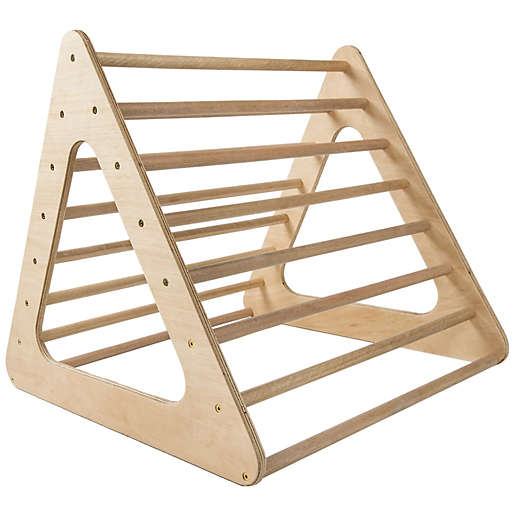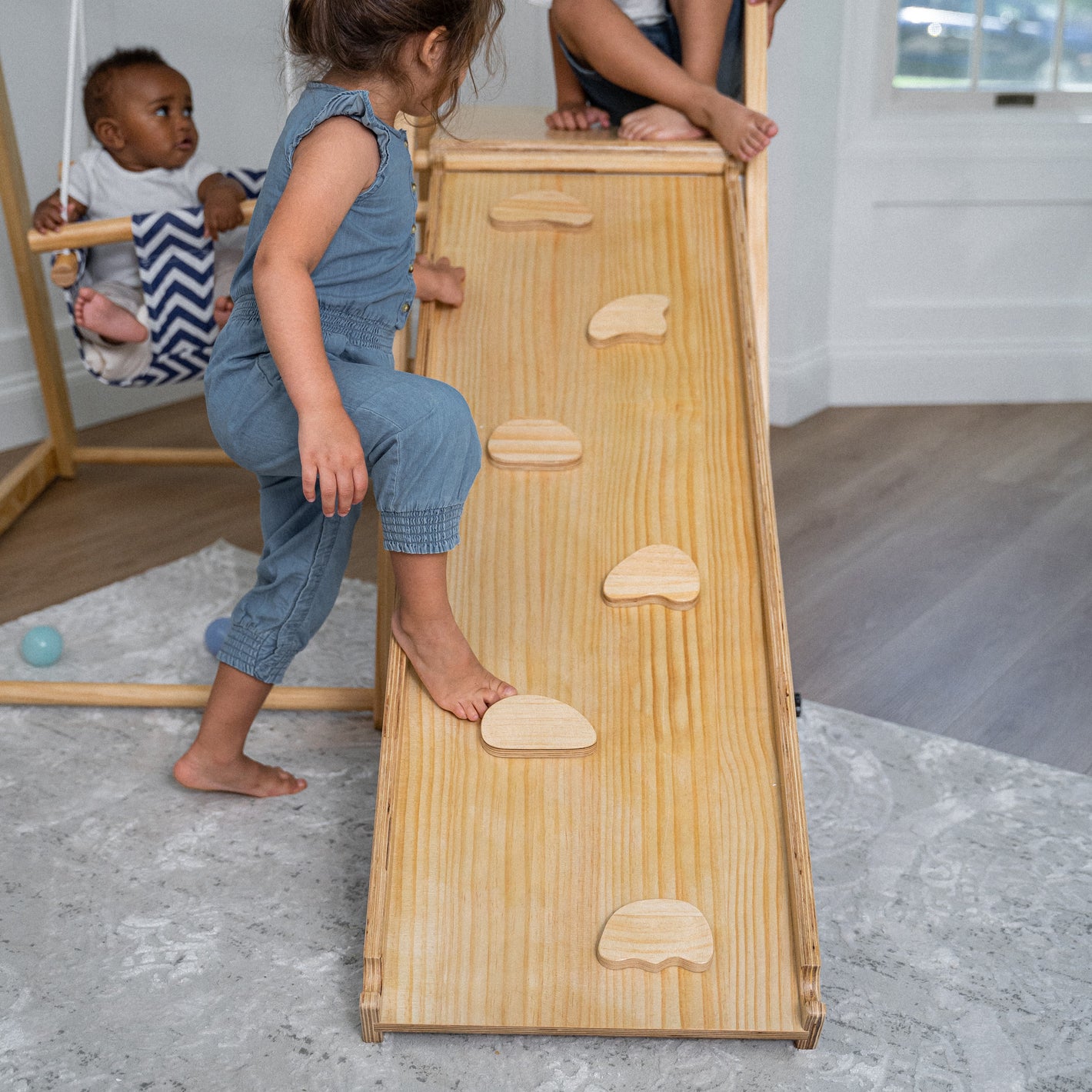The Complete Guide To Climbers & Climbing Walls For Children

It begins with your baby pulling up on the sofa. Before you know it, your toddler is climbing and scaling anything. Soon you’re blocking stairways and turning chairs upside down to impede your toddler from climbing. Welcome to the world of a climbing toddler!
Is Climbing Good for Toddlers?
The answer is a resounding yes. As humans, we were born to climb. Climbing is a natural part of the toddler and human development. Whether it’s, the living room sofa or the tree outside is irrelevant. Our bodies were ingeniously designed for climbing and moving. Climbing offers tremendous physical, mental, social, cardiovascular, and sensory benefits. The key is having the right equipment and parameters, and you’ll find the benefits of climbing for children will continue to grow the more active they are.
Why do toddlers climb?
The simple answer is that they can! Toddlers climb because it is a natural part of their development. They begin to gain greater control of their bodily movements. Couple that with their innate curiosity, and every piece of furniture or set of stairs is seen as a challenge.
What is a climber?
Climbers or playground climbers are an integral part of a child’s development. They are a piece of multi-purpose equipment designed for children to scale safely. It can be made of wood, plastic, metal, or any combination of these materials. Climbing challenges children as young as six months to use their hand-eye coordination and upper-body strength to pull themselves upwards using the rungs.
The following is a brief overview of some of the different climbers currently on the market.
-
Freestanding climbers
These types of climbers are available in many different sizes and set-ups. They can accommodate all age groups and sizes. Examples of freestanding climbers include Avenlur’s Pikler Triangle. It is designed for children as young as six months old. This piece of equipment has two purposes: it can act as a climber, or when you drape the tent canvas over, it becomes a tent, perfect for hiding from wild beasts when your children are in their imaginary jungle.

-
Net climbers
Avenlur’s, like most net climbers on the market, offers children an alternative to a traditional climbing ladder by providing a net. The unstable surface of a net adds a challenge to your bravest climber. Net climbers are usually available either as a freestanding structure or as part of a larger structure, in the case of the Magnolia.

-
Dome Climbers
Named for its geometric shape, this is a classic type of climber that usually has either square or triangular-shaped handholds. These large arched and curved dome climbers are best suited for groups of kids to play on simultaneously. They’re typically freestanding structures made of metal or durable plastic.
How to keep your child safe when climbing?
If you think you can stop or prevent your toddler from climbing, think again! Short of removing all your furniture and boxing your child into a room, there’s no way of getting around this stage of toddlerdom.
You can establish some basic safety guidelines to eliminate much of the danger. It will also provide a safe environment where your toddler can discover the joys of climbing.
-
Establish clear boundaries for indoor climbing
This means being consistent with your small person about what he’s allowed to climb and what is not up for negotiation with regards to climbing.
-
Provide safe and secure climbing structures
Whether you purchase Pikler Triangle Ladder and Climber Slide or opt for other climbing structures, the key is that it’s safe. Eliminate the teetering bookshelves that could easily fall over if pulled. Or the wobbly step stool the adults use to grab items in the kitchen that are too high. Your toddler needs a dedicated toy and space that meets their climbing needs exclusively.
-
Foresee Accidents
You might have already babyproofed your home and thought there was no need to do anything else, but as your toddler heads into the climbing stage, you need to take another look at your surroundings.
For instance, if you purchase a playhouse tent and climber, it’s worth investing in a soft landing mat that you can place under such climbing frames in case your toddler falls.
-
Supervise
You will need to be vigilant regardless if your child is playing on a larger playset with multiple features or another climbing frame. That means supervising your climbing child as they scale new heights and try different positions on the rungs.
-
Step in
Sometimes a toddler’s imagination is a little larger than their actual capabilities. This is particularly true when their ability to climb is all new to them. If you see your child climbing too high on the ladder or seeming stuck in a spot they just can’t get out of, that’s when you need to intervene.
What are the benefits of climbing for children?
The link between climbing and children is more than simply burning excess energy or exploring their curiosity. The benefits of climbing are endless, yet the following are just some of the most significant advantages of climbing.
-
Physical benefits of climbing
There are tremendous physical benefits for children who climb. Whether they’re scaling an indoor playground or rock climbing, it’s one of the greatest benefits of climbing for children. Other benefits of this low-impact activity include the following:
- An increase in overall physical strength, especially upper body strength, and muscle mass.
- An improvement in gross motor skills development as kids learn how engaging their bodies helps them climb more easily.
- An improvement in fine motor skills, including hand-eye coordination and the ability to hold objects.
- Better coordination, agility, balance, and speed as children learn to ascend and descend climbing structures.
- Honed visual perception and spatial awareness as children learn where and how to place their feet and hands as they face new and different climbing challenges.

-
Sensory benefits of climbing
This physical activity takes your child’s sensory awareness to new levels. Their proprioception senses, or where their limbs are relative to each other, are dramatically improved as they learn where to place their arms and legs on climbing frames.
Additionally, their vestibular senses, or spatial awareness abilities, are dramatically improved. This sense is also responsible for supporting walking, sitting, and standing. Other sensory benefits of climbing include the following:
- Learning how to swing from one handhold to another.
- Learning how to pull on a handhold to climb upwards.
- Comprehending how to pull up against footholds or rungs to ascend or descend a climbing structure.
-
Mental benefits of climbing
As children climb, they engage different parts of their brains in tremendously beneficial ways. For every move, they must concentrate on where to place their hands and feet and how to maintain their balance. What appears to be a simple action of ascending or descending a climber involves so much thinking and evaluation. Some of the mental health benefits include:
- Improved focus.
- Problem-solving in a systematic way.
- Visualizing a solution to the challenge of conquering a climber, such as an indoor folding playset.
- Improved short and long-term memory.
- Better decision-making skills.

-
Social Benefits of Climbing
Playing on climbing structures provides tremendous social benefits, whether at home with friends or in the park. Your child can develop social skills while interacting with other kids their age. This physical activity will help them hone their emotional regulation and self-control systems. Some other social benefits include the following:
- Increased confidence to face challenges head-on.
- Developing self-reliance as children work to ascend a climber independently.
- Greater resilience as children learn to work through temporary discomfort or fear.
- Providing a space to develop their imagination and creativity.
- Allowing for the expression of emotions (good or bad).
What to look for in a climbing frame?
-
Durability & Quality Craftsmanship
You want to find a climber that will outlast all the pulling, pushing, and jumping your child will do on it. Similarly, you’re looking for climbing structures that don’t require much maintenance. Rest assured, when you invest in any of Avenlur’s products, you’re buying a well-built piece of equipment backed by our 10-year warranty. If any of our products break or fail within the first ten years due to quality or defective material, we will replace them free of charge.
Our playgrounds, slides, and gyms are tested extensively to standardize product functionality and safety levels. They meet ASTM (American Society for Testing and Materials) and CPSIA (Consumer Product Safety Improvement Act) certifications.
Additionally, all of our products are made from sustainable New Zealand pine. They are sealed using natural-based lacquers, and all our climbing frames’ plastic components are free of DCA, a compound that can impede the proper functioning of a person’s liver or kidneys.
-
Easy to Assemble
We know you won’t expect a fully assembled playset to arrive at your front door when you order a climber from Avenlur. But you certainly don’t expect to spend hours trying to assemble it while your children anxiously await its completion.
This is never the case when you purchase Avenlur products such as the Palm 5-in-1 Outdoor and Indoor Playground. Yes, some assembly will be required, yet the instructions are straightforward, and we’re here to help should you have any questions.
-
Correct age and weight range
In purchasing a climber for your child or family, you must invest in one that is the correct size and can handle your little one’s weight. The international playground safety standards categorize climbers similarly to jungle gyms into three distinctive age groups. They are:
- Children two years old or younger
- Children between the ages of 2 to 5 years old
- Children between 5 and 12 years old.
The size of a climber for a two-year-old will not be the same as for a 12-year-old. Similarly, they won’t be able to handle an older child's weight compared to a three-year-old. That’s why all of Avenlur’s climbers identify the age range and suitable weight for their equipment. This ensures you are buying the most appropriate climber for your child.